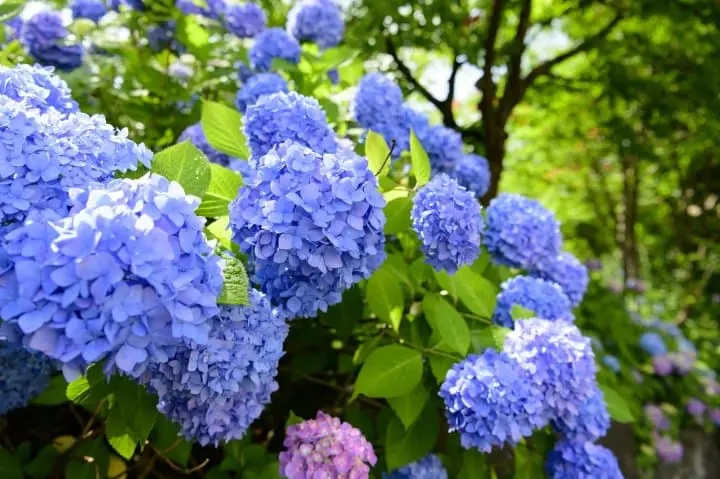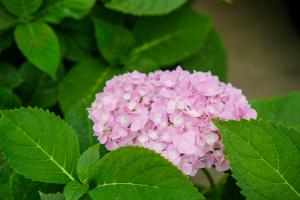
hydrangea
Hydrangeas are flowering shrubs that are native to Asia and the Americas. They are known for their large, showy flowers, which can be found in a range of colors including white, pink, purple, and blue. The color of the flowers can often be influenced by the acidity of the soil, with more acidic soil producing blue flowers and less acidic soil producing pink flowers.
There are several different types of hydrangeas, including mophead, lacecap, and oakleaf. Mophead hydrangeas have large, round flowers that resemble pom-poms, while lacecap hydrangeas have small flowers surrounded by larger, showier flowers. Oakleaf hydrangeas have leaves that resemble those of oak trees, and they produce clusters of white flowers in the summer.
Hydrangeas are easy to care for and can be grown in a variety of soil types as long as they receive plenty of sunlight. They can be grown in containers or in the ground, and they can be pruned to maintain their shape. They are popular plants for use in gardens and as decorative elements in landscaping.
how to propagate hydrangea
There are several methods for propagating hydrangeas, including rooting stem cuttings, layering, and dividing established plants.
To propagate hydrangeas from stem cuttings, follow these steps:
Choose a healthy stem from an existing hydrangea plant. It should be green and flexible, not woody.
Cut the stem into sections that are about 4-6 inches long. Make sure each section has at least one set of leaves.
Remove the lower leaves from the stem cuttings, leaving only the top set of leaves.
Dip the cut end of the stem cutting into rooting hormone. This will help encourage root growth.
Fill a pot with a mixture of equal parts peat moss and perlite. Water the mixture until it is evenly moist.
Plant the stem cuttings in the pot, making sure the leaves are above the soil line.
Cover the pot with a plastic bag to create a greenhouse effect. This will help keep the soil moist and warm.
Place the pot in a warm, bright location, but out of direct sunlight.
Check the cuttings every few days to make sure the soil is moist. Water as needed to keep the soil evenly moist.
After a few weeks, the cuttings should start to root. Once they have rooted, you can transplant them into a larger pot or into the ground.
Layering is another method of propagating hydrangeas. To layer a hydrangea, follow these steps:
Choose a low-lying stem on an existing hydrangea plant.
Bend the stem down to the ground and bury it under the soil, leaving the top set of leaves above the soil line.
Secure the stem in place with a rock or a plant stake.
Water the soil around the stem to help it root.
After a few weeks, the stem should start to root. Once it has rooted, you can cut it off from the parent plant and transplant it to a new location.
Finally, you can propagate hydrangeas by dividing an established plant. To do this, follow these steps:
Choose an established hydrangea plant that has multiple stems.
Dig up the plant and gently separate the roots into smaller sections, making sure each section has at least one stem with leaves.
Plant the sections in separate pots or in the ground.
Water the plants well and provide them with plenty of sunlight.
By following these steps, you can easily propagate hydrangeas and grow new plants from existing ones.
how to prune hydrangea
Pruning hydrangeas can help encourage new growth and maintain the shape of the plant. There are several different types of hydrangeas, and the specific pruning techniques will depend on the type of plant you have.
Here are some general guidelines for pruning hydrangeas:
Timing: The best time to prune hydrangeas is in late winter or early spring, before the plant starts to produce new growth.
Tools: Use clean, sharp pruning shears to make clean cuts.
Dead or damaged wood: Remove any dead or damaged wood from the plant. This will help improve the overall health and appearance of the plant.
Overgrown plants: If your hydrangea is overgrown or has become too large for its location, you can prune it back to a more manageable size. Make sure to remove any weak or spindly growth, and cut back the stems to just above a set of healthy leaves.
Mophead hydrangeas: These types of hydrangeas produce large, round flowers. To maintain their shape, prune back the stems to just above a set of healthy leaves in late winter or early spring.
Lacecap hydrangeas: These types of hydrangeas produce small flowers surrounded by larger, showier flowers. To maintain their shape, prune back the stems to just above a set of healthy leaves in late winter or early spring.
Oakleaf hydrangeas: These types of hydrangeas produce clusters of white flowers in the summer. To maintain their shape, prune back the stems to just above a set of healthy leaves in late winter or early spring.
By following these guidelines, you can effectively prune your hydrangea and maintain its health and appearance.
how to propogate hydrangea
There are several methods for propagating hydrangeas, including rooting stem cuttings, layering, and dividing established plants.
To propagate hydrangeas from stem cuttings, follow these steps:
Choose a healthy stem from an existing hydrangea plant. It should be green and flexible, not woody.
Cut the stem into sections that are about 4-6 inches long. Make sure each section has at least one set of leaves.
Remove the lower leaves from the stem cuttings, leaving only the top set of leaves.
Dip the cut end of the stem cutting into rooting hormone. This will help encourage root growth.
Fill a pot with a mixture of equal parts peat moss and perlite. Water the mixture until it is evenly moist.
Plant the stem cuttings in the pot, making sure the leaves are above the soil line.
Cover the pot with a plastic bag to create a greenhouse effect. This will help keep the soil moist and warm.
Place the pot in a warm, bright location, but out of direct sunlight.
Check the cuttings every few days to make sure the soil is moist. Water as needed to keep the soil evenly moist.
After a few weeks, the cuttings should start to root. Once they have rooted, you can transplant them into a larger pot or into the ground.
Layering is another method of propagating hydrangeas. To layer a hydrangea, follow these steps:
Choose a low-lying stem on an existing hydrangea plant.
Bend the stem down to the ground and bury it under the soil, leaving the top set of leaves above the soil line.
Secure the stem in place with a rock or a plant stake.
Water the soil around the stem to help it root.
After a few weeks, the stem should start to root. Once it has rooted, you can cut it off from the parent plant and transplant it to a new location.
Finally, you can propagate hydrangeas by dividing an established plant. To do this, follow these steps:
Choose an established hydrangea plant that has multiple stems.
Dig up the plant and gently separate the roots into smaller sections, making sure each section has at least one stem with leaves.
Plant the sections in separate pots or in the ground.
Water the plants well and provide them with plenty of sunlight.
By following these steps, you can easily propagate hydrangeas and grow new plants from existing ones.
when to prune hydrangea
The best time to prune hydrangeas is in late winter or early spring, before the plant starts to produce new growth. Pruning at this time will allow you to remove any dead or damaged wood and shape the plant before it starts to grow new shoots. It is also a good idea to prune hydrangeas after they have finished flowering, as this will allow you to shape the plant and remove any spent flowers.
It is generally not recommended to prune hydrangeas during the summer, as this can remove potential flower buds and reduce the number of blooms on the plant. However, if you do need to prune your hydrangea during the summer, be sure to only remove dead or damaged wood, and avoid cutting back the stems too severely.
By following these guidelines, you can effectively prune your hydrangea and maintain its health and appearance.
do deer eat hydrangea
Deer may occasionally eat hydrangeas, especially if they are hungry and there are no other food sources available. However, hydrangeas are not a preferred food for deer, and they are less likely to browse on them compared to other plants.
If you have a problem with deer eating your hydrangeas, there are a few things you can do to deter them:
Plant deer-resistant varieties: Some varieties of hydrangeas are less attractive to deer than others. Varieties that are known to be resistant to deer include 'Annabelle', 'Endless Summer', and 'PeeGee'.
Use deer repellents: There are several commercial deer repellents available that can help deter deer from eating your plants. These repellents can be sprayed on the plants or applied to the soil around the base of the plant.
Use physical barriers: Fencing or netting can help keep deer away from your hydrangeas. Be sure to use a fence that is tall enough to prevent deer from jumping over it.
Plant in containers: If you live in an area with a high deer population, you may want to consider growing your hydrangeas in containers. This will make it more difficult for the deer to access the plants.
By following these tips, you can help protect your hydrangeas from deer damage. However, it is important to note that there is no guaranteed way to prevent deer from eating your plants, and you may still experience some damage even if you take these precautions.

 jackfruit
jackfruit snake plant
snake plant hibiscus
hibiscus hydrangea
hydrangea lavender
lavender Green roses climb al...
Green roses climb al... If you don't pay att...
If you don't pay att... Management of four g...
Management of four g...





























